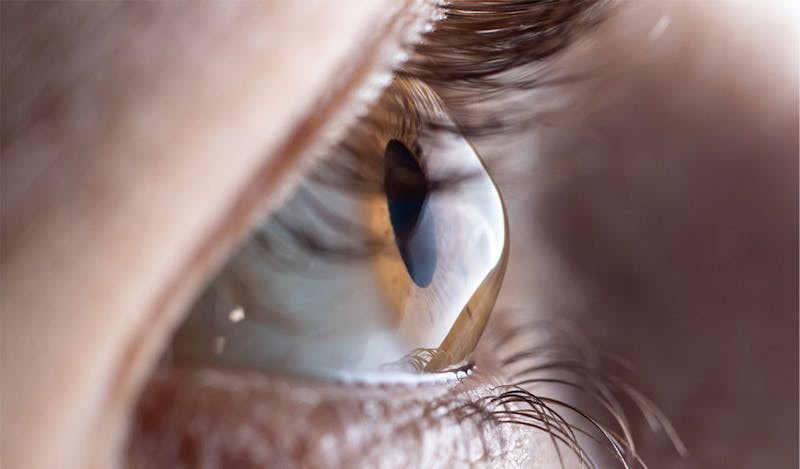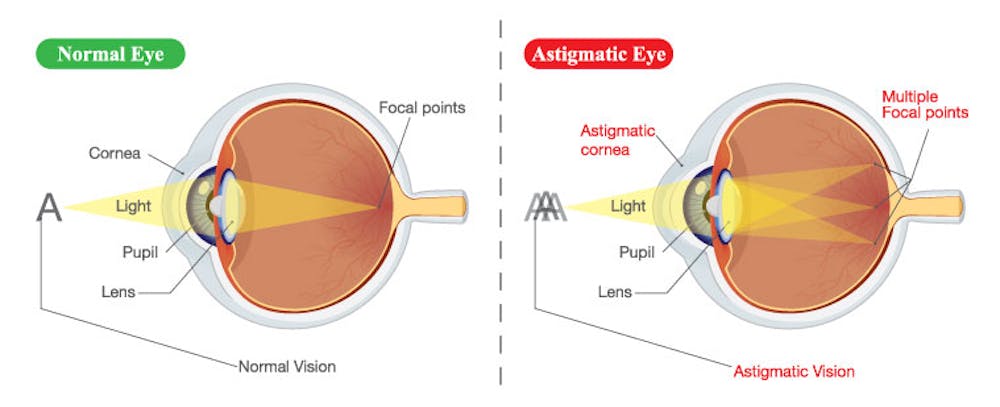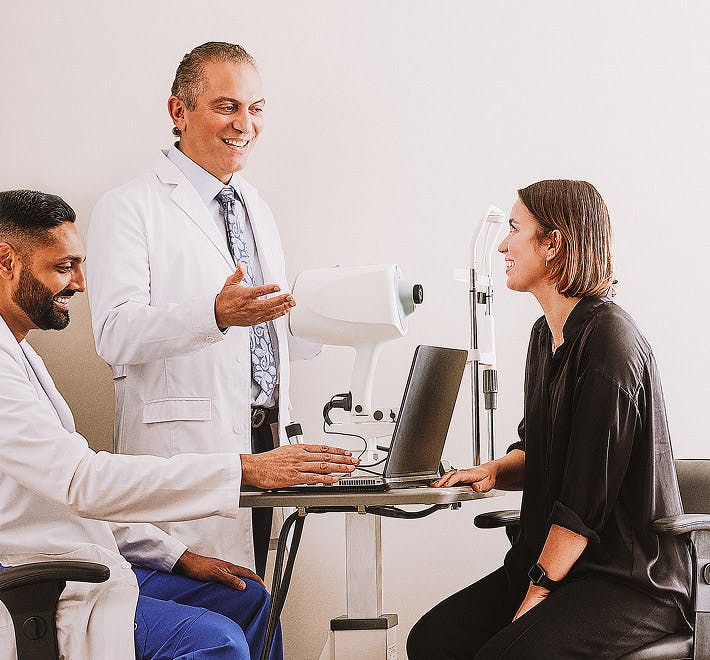Enhancing Your Vision
Guiding you toward the procedure that fits your unique needs, so you can see the world clearly and confidently.

Astigmatism is when the eye is shaped more like a football than a perfectly round ball. This makes things look blurry or wobbly because light doesn’t focus in the eye like it should. Imagine if you’re trying to shine a flashlight on a spot, but instead of one clear spot, you see a smudge or a blur. That’s what happens with astigmatism; the eye doesn’t make a clear “spot” for you to see sharply. Unlike nearsightedness which affects vision mainly for distance or farsightedness which affects vision mostly for near, astigmatism affects both near and far vision. 
Symptoms may include:
Astigmatism can be categorized into two main types:
Uncorrected astigmatism can significantly impact visual acuity and quality of life, impacting daily activities such as driving, reading, and using electronic devices. The effect of astigmatism on visual acuity and daily life can vary depending on the severity of the condition. It also affects both the near and far vision.
Addressing astigmatism through treatments such as contact lenses or LASIK astigmatism surgery can improve visual clarity and enhance overall quality of life. By addressing it, individuals can regain sharper vision and alleviate symptoms, allowing them to engage more comfortably in daily tasks.
LASIK (Laser-Assisted In Situ Keratomileusis) is a widely performed surgery that reshapes the cornea using a laser to correct refractive errors such as astigmatism. It is typically performed as an outpatient procedure and is known for its rapid recovery time and high success rates in achieving improved vision without needing corrective eyewear.
LASIK corrects astigmatism by reshaping the cornea to achieve a more uniform curvature, allowing light to focus correctly on the retina. There are several direct benefits of the surgery, including:
Most people have some degree of irregular astigmatism. Although it is rarely severe enough to be classified clinically as such, it often causes some degree of visual distortion. This is the reason that procedures like topography-guided LASIK or Contoura, have been consistently shown to be superior in visual results to traditional LASIK. Topography-guided LASIK, or Contoura, creates detailed maps of the cornea’s surface, enabling the surgeon to tailor the treatment to the individual’s unique visual aberrations and corneal irregularities. The use of Contoura optimizes the outcomes of astigmatism correction.
Patients must undergo a comprehensive eye exam to determine their candidacy for the procedure. General eligibility requirements:
Choosing an experienced cornea specialist with expertise and a proven track record in successful LASIK surgery is essential for achieving optimal outcomes. A reputable surgeon prioritizes patient safety, provides thorough pre-operative evaluations, and provides comprehensive post-operative care, ensuring the best chances for long-term effective treatment.
While LASIK is a widely performed procedure for astigmatism correction, the surgeon may recommend other options, such as PRK (Photorefractive Keratectomy) or SMILE (Small Incision Lenticular Extraction), in certain cases. Understanding the differences between these procedures is essential for making informed treatment decisions.
Topography-guided PRK is usually preferable for significant irregular astigmatism due to its ability to address complex corneal irregularities with customization and precision. Unlike LASIK, PRK does not utilize a thin flap but instead directly reshapes the corneal surface. This makes it well-suited for cases where the cornea is too thin or irregular for flap creation such as in keratoconus. In Keratoconus, before doing any type of corrective laser treatment on the eye the patient must have collagen cross linking first.
Each refractive (corrective vision procedure) procedure has unique advantages and limitations, which should be carefully considered based on individual patient vision, health, and preferences. Consulting with an experienced cornea specialist is essential for determining the most suitable treatment option.
Personalized treatment plans are essential in addressing astigmatism, and made easier with the use of topography. A thorough evaluation and consultation process helps ensure the chosen treatment aligns with the patient’s goals and expectations.
Before LASIK surgery for astigmatism, patients must undergo a comprehensive eye examination to assess their candidacy and discuss treatment options. This includes evaluating refractive error, ocular health, and systemic health and thoroughly measuring the cornea.
Understanding LASIK surgery risks, benefits, and expected outcomes is essential for informed decision-making. Clear communication between the surgeon and patient helps manage expectations, alleviate concerns, and ensure the process goes smoothly.
Preparing mentally and physically for LASIK surgery involves following the surgeon’s pre-operative instructions, such as avoiding contact lenses, staying hydrated, and arranging for transportation on the day of the procedure. It is recommended that questions be written down before the first visit with the surgeon.
During LASIK surgery, the surgeon numbs the eye with anesthetic drops and uses a laser (All Laser LASIK) or a circular blade (traditional LASIK) to create a thin flap on the cornea. The underlying corneal tissue is then reshaped to correct the refractive error.
Advanced technologies such as wavefront-guided (older technology, less commonly used today) and topography-guided treatments enhance the precision and accuracy of LASIK surgery, resulting in improved visual outcomes and reduced risk of complications.
LASIK surgery is typically quick and painless, with most patients experiencing improved vision immediately after the procedure. Mild discomfort and temporary side effects such as dry eyes and sensitivity to light are common during the initial recovery period.

Following LASIK surgery, patients are advised to avoid strenuous activities for a few days. The surgeon may prescribe pain medication and lubricating eye drops to manage discomfort and promote healing.
Regular follow-up appointments are essential to monitor vision progression and address concerns. These appointments also allow for adjustments to the post-operative care regimen as needed.
Adopting healthy lifestyle habits such as staying hydrated, avoiding eye strain, and protecting the eyes from UV exposure can promote optimal healing and visual rehabilitation following LASIK or PRK surgery.
In most cases, Lasik can completely eliminate astigmatism, significantly improving visual acuity and quality of life. However, individual results may vary. In rare cases an enhancement procedure may be needed.
While LASIK surgery offers rapid visual recovery for many patients, it’s important to understand that complete stabilization of vision may take several weeks to months. Realistic expectations and patience are key to a successful outcome.
While LASIK surgery is considered safe and effective for most patients, as with all medical procedures, there are potential risks and complications to be aware of. These can include dry eye symptoms, glare, halos, under-correction, over-correction, and, in rare cases, more severe complications such as infection or corneal ectasia. Discussing these risks with the surgeon during the consultation process is crucial to ensure a thorough understanding of what to expect and how to minimize the likelihood of complications.
The impact of improved vision on daily life and activities following LASIK surgery for astigmatism can be transformative. With clearer, sharper vision, individuals often find themselves more confident and capable in various aspects of daily life. Once challenging tasks like driving at night or reading small print become significantly more manageable and enjoyable.
Guiding you toward the procedure that fits your unique needs, so you can see the world clearly and confidently.




If you do not see your preferred date and time please call the office, so we can accommodate your request (917) 398-4011.